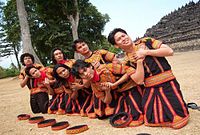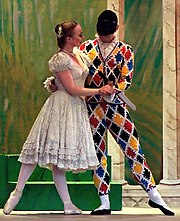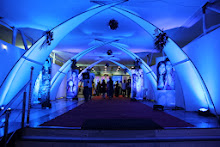Dance is an art form that generally refers to movement of the body, usually rhythmic and to music,[1] used as a form of expression, social interaction or presented in a spiritual or performance setting.
Dance may also be regarded as a form of nonverbal communication between humans, and is also performed by other animals (bee dance, patterns of behaviour such as a mating dance). Gymnastics, figure skating and synchronized swimming are sports that incorporate dance, while martial arts kata are often compared to dances. Motion in ordinarily inanimate objects may also be described as dances (the leaves danced in the wind).
Definitions of what constitutes dance are dependent on social, cultural, aesthetic, artistic and moral constraints and range from functional movement (such as folk dance) to virtuoso techniques such as ballet. Dance can be participatory, social or performed for an audience. It can also be ceremonial, competitive or erotic. Dance movements may be without significance in themselves, such as in ballet or European folk dance, or have a gestural vocabulary/symbolic system as in many Asian dances. Dance can embody or express ideas, emotions or tell a story.
Dancing has evolved many styles. Breakdancing and Krumping are related to the hip hop culture. African dance is interpretive. Ballet, Ballroom, Waltz, and Tango are classical styles of dance while Square and the Electric Slide are forms of step dances.
Every dance, no matter what style, has something in common. It not only involves flexibility and body movement, but also physics. If the proper physics is not taken into consideration, injuries may occur.
Choreography is the art of creating dances. The person who creates (i.e., choreographs) a dance is known as the choreographer.
Dance studies and techniques
In the early 1920s, dance studies (dance practice, critical theory, Musical analysis and history) began to be considered an academic discipline. Today these studies are an integral part of many universities' arts and humanities programs. By the late 20th century the recognition of practical knowledge as equal to academic knowledge lead to the emergence of practice research and practice as research. A large range of dance courses are available including:
- Professional practice: performance and technical skills
- Practice research: choreography and performance
- Ethnochoreology, encompassing the dance-related aspects of anthropology, cultural studies, gender studies, area studies, postcolonial theory, ethnography, etc.
- Dance therapy or dance-movement therapy.
- Dance and technology: new media and performance technologies.
- Laban Movement Analysis and somatic studies
Dance competitions

A dance competition is an organized event in which contestants perform dances before a judge or judges for awards and, in some cases, monetary prizes. There are several major types of dance competitions, distinguished primarily by the style or styles of dances performed. Major types of dance competitions include:
- Competitive dance, in which a variety of theater dance styles—such as acro, ballet, jazz, hip-hop, lyrical, and tap—are permitted.
- Open competitions, which permit a wide variety of dance styles. A popular example of this is the TV program So You Think You Can Dance.
- Dancesport, which is focused exclusively on ballroom and latin dance. Popular examples of this are TV programs Dancing with the Stars and Strictly Come Dancing.
- Single-style competitions, such as highland dance, dance team, and Irish dance, which only permit a single dance style.
Today, there are various dances and dance show competitions on Television and the Internet.
Dance occupations
There are different careers connected with dancing: Dancer, dance teacher, dance sport coach, dance therapist and choreographer.
- Dancer
Dance training differs depending on the dance form. There are university programs and schools associated with professional dance companies for specialised training in classical dance (e.g. Ballet) and modern dance. There are also smaller, privately owned dance studios where students may train in a variety of dance forms including competitive dance forms (e.g. Latin dance, ballroom dance, etc.) as well as ethnic/traditional dance forms.
Professional dancers are usually employed on contract or for particular performances/productions. The professional life of a dancer is generally one of constantly changing work situations, strong competition pressure and low pay. Professional dancers often need to supplement their income, either in dance related roles (e.g., dance teaching, dance sport coaches, yoga) or Pilates instruction to achieve financial stability.
In the U.S. many professional dancers are members of unions such as the American Guild of Musical Artists, the Screen Actors Guild and Actors' Equity Association. The unions help determine working conditions and minimum salaries for their members.
- Dance teachers
Dance teacher and operators of dance schools rely on reputation and marketing. For dance forms without an association structure such as Salsa or Tango Argentino they may not have formal training. Most dance teachers are self employed.
- Dancesport coaches
Dancesport coaches are tournament dancers or former dancesports people, and may be recognised by a dance sport federation.
- Choreographer
Choreographers are generally university trained and are typically employed for particular projects or, more rarely may work on contract as the resident choreographer for a specific dance company. A choreographic work is protected intellectual property. Dancers may undertake their own choreography.
Dance in South Asia
India

During the first millennium BCE in India, many texts were composed which attempted to codify aspects of daily life. In the matter of dance, Bharata Muni's Natyashastra (literally "the text of dramaturgy") is the one of the earlier texts. Though the main theme of Natyashastra deals with drama, dance is also widely featured, and indeed the two concepts have ever since been linked in Indian culture. The text elaborates various hand-gestures or mudras and classifies movements of the various limbs of the body, gait, and so on. The Natyashastra categorised dance into four groups and into four regional varieties, naming the groups: secular, ritual, abstract, and, interpretive. However, concepts of regional geography has altered and so have regional varieties of Indian dances. Dances like "Odra Magadhi", which after decades long debate, has been traced to present day Mithila-Orissa region's dance form of Odissi, indicate influence of dances in cultural interactions between different regions.[4]
From these beginnings rose the various classical styles which are recognised today. Therefore, all Indian classical dances are to varying degrees rooted in the Natyashastra and therefore share common features: for example, the mudras, some body positions, and the inclusion of dramatic or expressive acting or abhinaya. The Indian classical music tradition provides the accompaniment for the dance, and as percussion is such an integral part of the tradition, the dancers of nearly all the styles wear bells around their ankles to counterpoint and complement the percussion.
Bhangra in the Punjab
The Punjab area overlapping India and Pakistan is the place of origin of Bhangra. It is widely known both as a style of music and a dance. It is mostly related to ancient harvest celebrations, love, patriotism or social issues. Its music is coordinated by a musical instrument called the 'Dhol'. Bhangra is not just music but a dance, a celebration of the harvest where people beat the dhol (drum), sing Boliyaan (lyrics) and dance.It developed further with the Vaisakhi festival of the Sikhs.
Ballet
Ballet developed first in Italy and then in France from lavish court spectacles that combined music, drama, poetry, song, costumes and dance. Members of the court nobility took part as performers. During the reign of Louis XIV, himself a dancer, dance became more codified. Professional dancers began to take the place of court amateurs, and ballet masters were licensed by the French government. The first ballet dance academy was the Académie Royale de Danse (Royal Dance Academy), opened in Paris in 1661. Shortly thereafter, the first institutionalized ballet troupe, associated with the Academy, was formed; this troupe began as an all-male ensemble but by 1681 opened to include women as well.[2]
20th century concert dance
At the beginning of the 20th century, there was an explosion of innovation in dance style characterized by an exploration of freer technique. Early pioneers of what became known as modern dance include Loie Fuller, Isadora Duncan, Mary Wigman and Ruth St. Denis. The relationship of music to dance serves as the basis for Eurhythmics, devised by Emile Jaques-Dalcroze, which was influential to the development of Modern dance and modern ballet through artists such as Marie Rambert. Eurythmy, developed by Rudolf Steiner and Marie Steiner-von Sivers, combines formal elements reminiscent of traditional dance with the new freer style, and introduced a complex new vocabulary to dance. In the 1920s, important founders of the new style such as Martha Graham and Doris Humphrey began their work. Since this time, a wide variety of dance styles have been developed; see Modern dance.




guud job
ReplyDelete
ReplyDeleteRajasthan tours to India offer a wide array of Heritage Rajasthan Tour Packages that includes Castle Tour Of Rajasthan, Forts and Palaces Tour Of Rajasthan, Rajasthan Forts and Palaces Tour With Taj. Book Heritage Rajasthan Tour Packages with the best price guarantee.
Thanks for sharing the information. Every state of India has a unique culture and so accordingly they have special dance culture. Thanks for sharing the information in so bifurcated way.
ReplyDeleteClassical Dance Classes in Bangalore| Bharatnatyam Classes in Koramangala| Learn Mohiniyattam In Bangalore| Bharatnatyam Classes in Bangalore| Bharatnatyam Classes in Whitefield| Bharatnatyam dance class near me| Top Bharatnatyam Classes In Kormanagala| Bharatnatyam Classes In BTM| Bharatanatyam Dance Classes Bangalore
It is really a nice and helpful piece of information. I’m glad that you shared this helpful info with us. Please keep us informed like this. Thank you for sharing. led tron dance
ReplyDelete